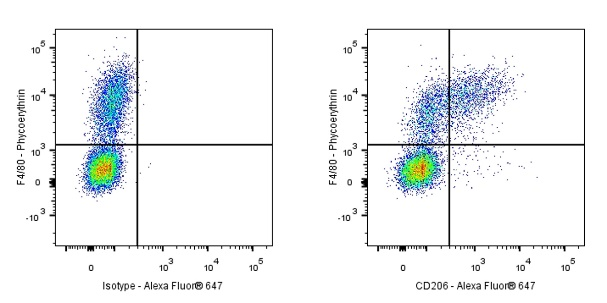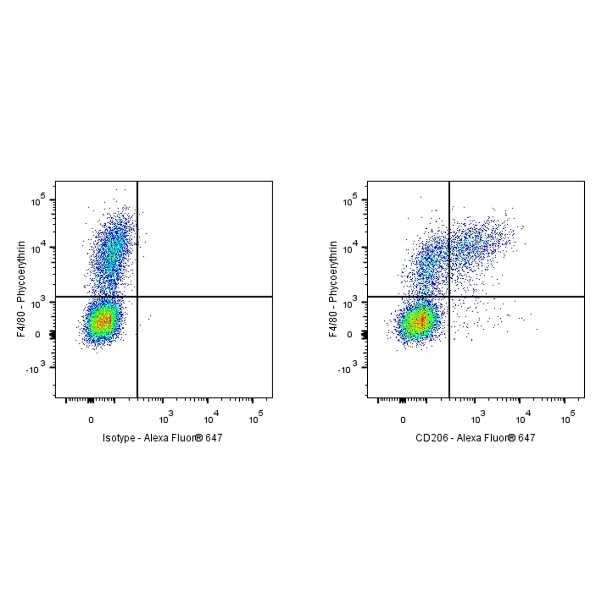| Flow cytometric analysis of Mouse CD206 (MMR) expression on BALB/c mouse peritoneal exudates cells. BALB/c mouse peritoneal exudates cells were stained with SDT Phycoerythrin Rat Anti-Mouse F4/80 Antibody and either Alexa Fluor® 647 Rat IgG2a, κ Isotype Control (Left panel) or SDT Alexa Fluor® 647 Rat Anti-Mouse CD206 (MMR) Antibody Antibody (Right panel) at 1.25 μl/test. Flow cytometry and data analysis were performed using BD FACSymphony™ A1 and FlowJo™ software. |
Product Details
Product Details
Product Specification
| Host | Rat |
| Antigen | CD206 (MMR) |
| Synonyms | Macrophage mannose receptor 1; MMR; Mrc1 |
| Location | Endosome, Cell membrane |
| Accession | Q61830 |
| Clone Number | S-R498 |
| Antibody Type | Rat mAb |
| Isotype | IgG2a,k |
| Application | ICFCM |
| Reactivity | Ms |
| Purification | Protein G |
| Concentration | 0.2 mg/ml |
| Conjugation | Alexa Fluor® 647 |
| Physical Appearance | Liquid |
| Storage Buffer | PBS, 25% Glycerol, 1% BSA, 0.3% Proclin 300 |
| Stability & Storage | 12 months from date of receipt / reconstitution, 2 to 8 °C as supplied. |
Dilution
| application | dilution | species |
| FCM | 1.25μl per million cells in 100μl volume |
Background
CD206, also known as the mannose receptor (MR) or mannose receptor C type 1 (MRC1), is a transmembrane glycoprotein that belongs to the C-type lectin family. It is predominantly expressed by tissue macrophages, dendritic cells, and certain lymphatic or liver endothelial cells. CD206 recognizes and mediates endocytosis of pathogens by binding to glycoproteins terminated with mannose. This receptor serves as a homeostatic receptor by binding and scavenging unwanted high mannose N-linked glycoproteins as well as pituitary hormones from the circulation. In addition, CD206 is a marker for the M2 phenotype of macrophages, which are involved in immunosuppression, tissue remodeling, and Th2 effector responses. Its expression is regulated by various cytokines and is considered a marker of an M2-like macrophage phenotype.
Picture
Picture
FC



